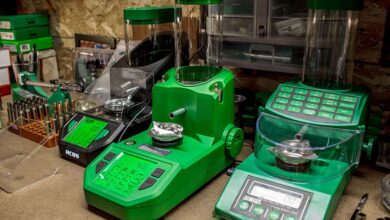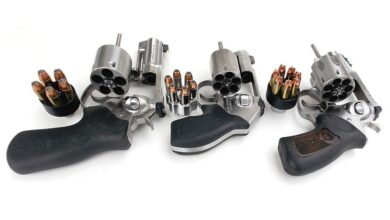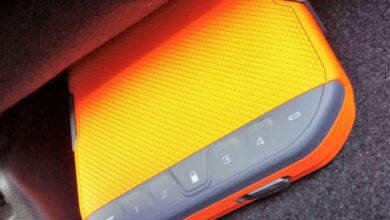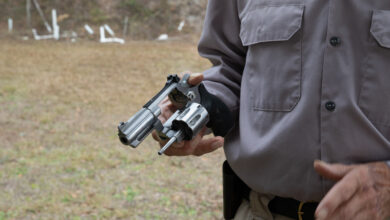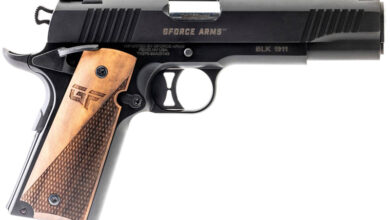Vortex Crossfire HD 1400 Laser Rangefinder Review
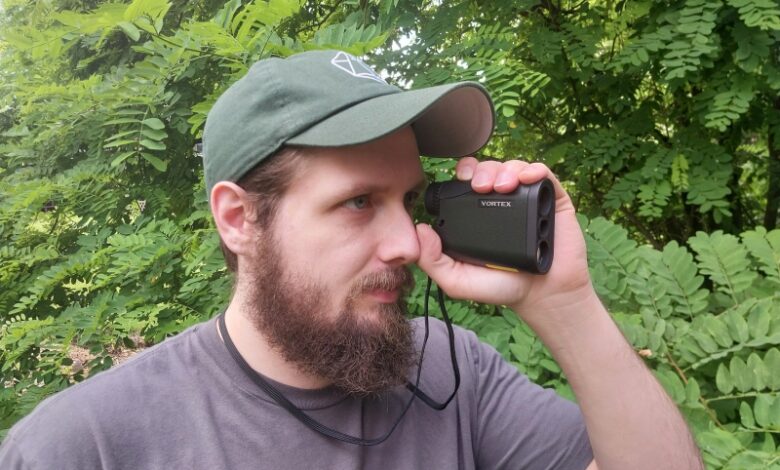
I finally broke down and got a laser rangefinder. A Vortex Crossfire HD 1400. I never really needed one because my hunting scouts are thorough, and I know the ranges for my likeliest shots. I can estimate from there. But testing guns and accessories like I do requires me to know ranges more precisely, and pacing it off gets old, especially if I’m sharing the shooting range that day. I got a spotting scope for the same reason.
Now I wonder why I waited so long. This rangefinder has eased my job considerably while also making me more precise. And it will admittedly help me in the deer woods. So, here’s my take on the Vortex Crossfire HD 1400 from a guy who often grumbles about relying too heavily on technology. Let’s start with the specs.
Vortex Crossfire HD 1400 Rangefinder Specifications
- Magnification: 5x
- Objective Lens Diameter: 21mm
- Reticle: Horizontal Component Distance (HCD) Corrected Shoot-To Range
- Max Reflective Range: 1,400 Yards
- Tree Range: 950 Yards
- Deer Range: 750 Yards
- Accuracy: +/- 1 Yard at 100 Yards; +/- 2 Yards at 100 to 1,000 Yards; +/- 3 Yards at 1,000+ Yards
- Max Angle Reading: +/- 89 Degrees
- Linear Field of View: 367 Feet at 1,000 Yards
- Angular Field of View: 7 Degrees
- Eye Relief: 16mm
- Length: 4 Inches
- Height: 2.9 Inches
- Width: 1.3 Inches
- Weight: 4.8 Ounces
- Battery Type: 1 CR2 (included)

Crossfire HD 1400 Features
The HD optical system is made with select glass for better resolution, less chromatic aberration, and superior color fidelity and light transmission. Edge-to-edge sharpness is there, with no blurring. Premium anti-reflective coatings on all air-to-glass surfaces enhance light transmission and clarity. The diopter ring lets you refine your focus. A red Transparent Organic LED (TOLED) display keeps the readouts clear in any light.
Ultra-hard ArmorTek lens coatings protect against scratches, oil, and dirt. The Crossfire HD is waterproof and shockproof to handle bad weather and high impact levels. Vortex includes a protective carrying case and lanyards to help secure your rangefinder. This product is also compact and light, weighing only 4.8 ounces.
The Crossfire HD 1400 has three targeting modes (Normal, 1st, and Last) to help zero in the correct range on the correct target. I’ll explain how those work below. There are also two ranging modes: Horizontal Component Distance (HCD) and Line of Sight (LOS). The HCD mode is the default factory setting. I’ll get into those, as well.
The effective ranges are 1,400 yards on a reflective target, 950 yards on a less reflective target like a tree, and 750 yards on a game animal like a deer. The optic can also range in meters if you prefer. The auto-shutoff feature powers down the optic after 20 seconds of inactivity in Menu mode, preserving the battery.
Running the Vortex Crossfire HD 1400 Rangefinder
I found the Crossfire HD 1400 to be easy and intuitive. I often struggle with technology, but I was actually surprised by how simple it is. The “Menu” and “Measure” buttons are the only controls. “Menu” does exactly what you’d think, and each mode or option is set by combining the two buttons to toggle through the choices using the TOLED display.

The display itself is clear and visible without being too busy or too bright. Once I had the settings right, I merely hit the “Measure” button and bounced the laser off my target. The half-second response time gives me near-instantaneous feedback.
The three targeting modes are cycled by hitting the “Menu” button after you press “Measure.” The display shows “1st” or “Last” and is blank for “Normal” mode. “Normal” is the default mode, bouncing the laser off whatever it’s aimed at. “1st” mode enables you to range the nearest object against a cluttered background, like, say, a deer standing on the edge of a tree line. “Last” mode is the opposite, allowing you to push through trees and brush to range an animal or target inside that tree line or perhaps behind a fence.
I really like the panning feature when in “Normal” mode. I can scan a downrange area, with the rangefinder constantly updating the range as I pan across the landscape. I don’t have to stop and manually range each individual object I look at.

Ranging Modes
The two ranging modes require a brief explanation. I’m no mathematician, but most of us know that shooting at a downward angle is different from shooting across a flat landscape. Arrows and bullets tend to travel higher than we intend. Mel Gibson had it right when he said, “Aim small, miss small.”
The Crossfire HD 1400’s HCD mode accounts for those downward angles. HCD stands for “Horizontal Component Distance.” I honestly can’t break down that term to explain it. All I know is that it computes the correct range for that angle, allowing you to employ your normal holds for that distance. HCD is the rangefinder’s default mode, but you can easily toggle to the “Line of Sight” (LOS) mode if you prefer.
LOS is the straight-line distance to the target without accounting for the downward angle. Vortex only recommends LOS mode for shooters using ballistic devices and shooting at distances beyond 500 yards with slopes greater than 15 degrees.

Parts of my rifle range have a slight downward slope. It’s no big deal at 50 yards, but it becomes a bit of an issue at 100. I’ve learned over time where my holds should be on that range at 100 yards, but the Crossfire HD 1400 now gives me the exact range to go with it, and I shoot more confidently.
Final Thoughts
I once resisted getting a rangefinder. I’ve officially entered the “Get Off My Lawn” phase of my life, and I don’t like carrying a bunch of gadgets around. But this little gadget is useful at the range, and I expect it to be useful in the woods. The Crossfire HD 1400 is lightweight and compact, so it doesn’t add much, if anything, to my normal load out. And I can attach the case to my belt or pack until I need it. Honestly, it’s light enough that you can keep it around your neck if you want. I don’t think I will, but you do you.
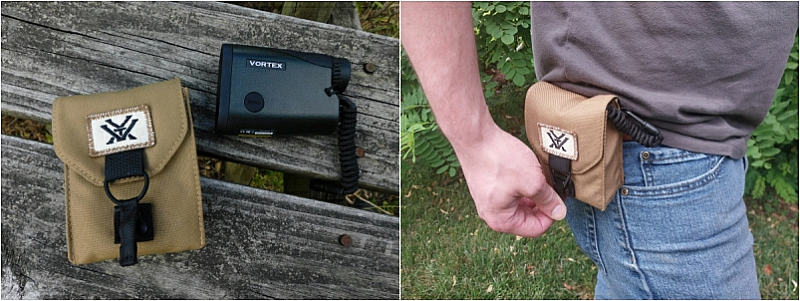
I don’t use tree stands anymore, but I do perch myself near ridge tops where I can look down on likely deer crossings. Those Appalachian ridges can be steep. Now, I can get the true range of my landmarks for a more accurate shot. It makes me a more ethical hunter, I think.
I may be slow to adopt technology, but I do know when I find something useful. This rangefinder will become an essential part of my kit moving forward. If you haven’t tried a rangefinder yet, maybe give this one a look. If I can use it, anyone can.
The post Vortex Crossfire HD 1400 Laser Rangefinder Review appeared first on The Mag Life.
Read the full article here

